On a record-cold night in December 2009, my husband, Casey, and I walked slowly around our frozen fields. I paused and leaned on him as each labor contraction interrupted our circuit, my mind focused more on the new life inside me than on the winter vegetables. Eventually, I returned to our house and continued laboring next to the woodstove.
Just past midnight our first child was born. Our life and work on the farm were never the same again.
We’d been operating our farm Oakhill Organics for four seasons before becoming parents. Children were always part of our vision of life on our Oregon farm, although that vision seemed hazier than planning our crop rotations and marketing plans. We both read the nostalgic farm family literature on children’s bookshelves, such as Laura Ingalls Wilder’s Farmer Boy. We knew our life wouldn’t look like 19th century rural New York, but we didn’t have many alternate visions.
So, in 2010 we entered our fifth season with some plans and hopes and a baby, feeling our way into the new reality. The biggest change for Casey and me was a profound shift in our partnership — a relationship filled with togetherness and equality had to adjust by necessity. Gone were long summer days of farming side-by-side until twilight, then eating a late simple dinner, showering and falling into bed.
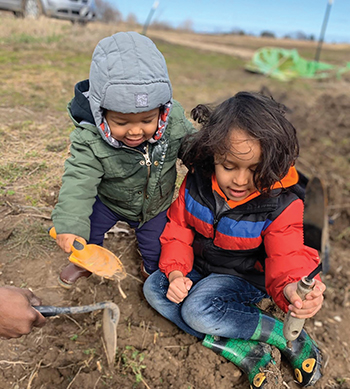 Giving kids their own small tools can be a great play-based way to keep them safe and entertained on a farm, such as here where Maxwell and Mason Scales “help” their father Martice at Full Circle Healing Farm (formerly Scales Family Farm) in Mequon, Wisconsin. Photo courtesy Martice Scales.
Giving kids their own small tools can be a great play-based way to keep them safe and entertained on a farm, such as here where Maxwell and Mason Scales “help” their father Martice at Full Circle Healing Farm (formerly Scales Family Farm) in Mequon, Wisconsin. Photo courtesy Martice Scales.
We hired an employee to replace my hands in the field, and I became the primary parent. While the farm was still our shared project and our family’s livelihood, we had delineated roles going forward.
That year brought the first of many big changes and evolutions to our farm and family, a process that intensified and continued when our second child was born in 2012.
How do farmer-parents do it?
Our story unfolded on its own unique trajectory, influenced by who Casey and I were, our farm business, and our children’s temperaments and needs. Other farmer-parents have faced slightly different challenges or met the same challenges with different solutions. But I have yet to meet a farmer-parent who does not acknowledge that balancing these two roles in life requires problem solving and compromises at every step.
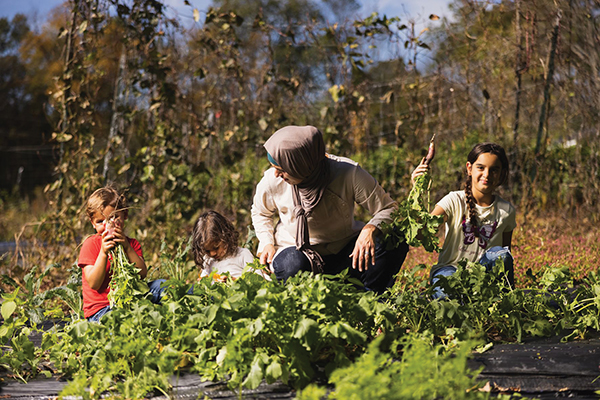 Diane Saleh harvests with her three children at Halal Pastures, Rock Tavern, New York. Photo courtesy Diane Saleh.
Diane Saleh harvests with her three children at Halal Pastures, Rock Tavern, New York. Photo courtesy Diane Saleh.
When personal and professional roles overlap and share physical time and space, there is no denying that how we navigate our relationships can make or break our businesses, making parenting a topic worth discussing within farming conversations.
Knowing there is no one-size-fits-all solution, I reached out to dozens of farmer-parents to hear about their experiences. I received input about how they meet (or at least try to meet) the common challenges of parenting from farmers in different regions, growing different farm products, with different family dynamics and make-ups.
This article captures stories and insights they were eager to share — not to mention how they found space for positive relationships amidst all the consuming work.
First problem to solve: childcare
Children need full-time supervision and care for the first years of their lives to meet physical and emotional needs and help them accomplish basic life tasks (such as eating and pottying). Childcare is real work that can be hard to do at the same time as other work, so most farmers need to answer the question: “Who will watch the baby and kids?” In Wilder’s Little House books, the solution to childcare was easy: the mother (and older siblings) watched the little children and did inside domestic tasks while the father worked outside on the farm. End of story.
In the 21st century, however, this question is necessarily more complicated. In many farm families, both parents want to remain full-time farmers, or the mother is the primary farmer, or there is only one parent (also the farmer), or the parents are two dads or two moms.
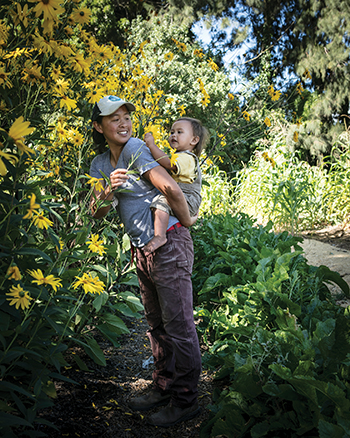 Iming Lin and her daughter make time outside of work hours to play and enjoy the sunchoke flowers at Meuse Farm, Hout Bay, South Africa. Photo courtesy Iming Lin.
Iming Lin and her daughter make time outside of work hours to play and enjoy the sunchoke flowers at Meuse Farm, Hout Bay, South Africa. Photo courtesy Iming Lin.
Regardless of family size and make-up, there seems to be two main approaches to childcare: farmer-parents who work with children alongside and the farmer-parents who make other arrangements for the children’s care during work time. Of course, many parents employ a hybrid of both approaches.
Farming with children
It seems that the ability to work with children present requires a particular combination of parent/child temperament as well as a philosophical dedication to incorporating children into the farm work.
Indeed, for John McCafferty of Pleasant River Produce in East Otago, New Zealand, farming full-time became a way for him to stay on the farm after his partner died soon after the birth of their daughter. He managed his salad crop operation while parenting, even as he had another child with a new partner. “I find working with a baby a lot easier than working with a toddler, it gets harder as they become mobile and also challenge boundaries,” he admitted.
To help make the farming-parenting combination possible, John intentionally kept his operation small to be child-friendly. “Farming better on a smaller footprint means you don’t have to carry your child so far.” John also recommended a good baby monitor and a flashlight for making use of naps and bedtimes. Now, with two children and a third on the way, he has more help, both with the children and with the farm.
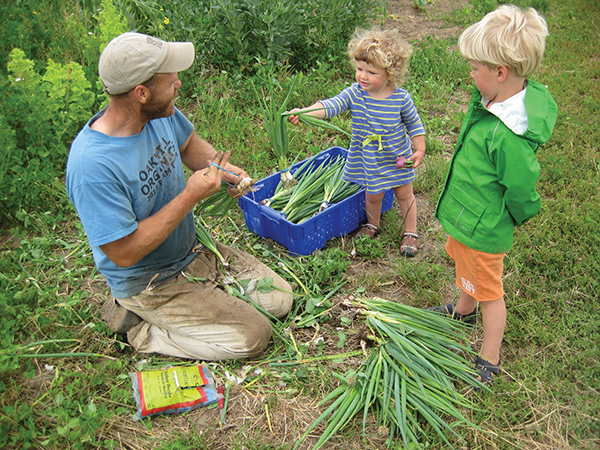 The author’s husband Casey and their children harvest green onions together at their farm Oakhill Organics, Dayton, Oregon.
The author’s husband Casey and their children harvest green onions together at their farm Oakhill Organics, Dayton, Oregon.
Many other farmers also particularly chose farming to spend more time with their children at work. Diane Saleh of Halal Pastures Farm in Rock Tavern, New York, said that her three children are intimately involved in the farm, which produces meat and vegetables “They harvest, plant and take care of the animals,” she said. “Our family life is our farm life. It’s one and the same.”
As homeschoolers, the farm also is a big part of their education and they host a “kids farm co-op,” where kids from other families come to learn about farming, life cycles, and science. For market days, other family help watch the children.
April Lennon Simpson of Farm to Vittles in Delco, North Carolina, sees her farm as an important form of horticulture therapy for her eight children, several of whom have special medical needs. “My oldest daughter, who is autistic, has found farming a comfort,” April said. “It has helped with her anxiety and feeling she can contribute.”
Simpson’s children range in age from two to 25, and they all are involved in the farm in some way. With this age range, the older children are also able to help mentor and watch the younger children while they are all on the farm together.
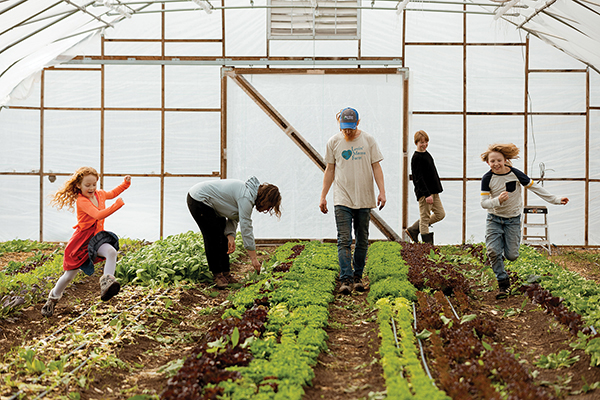 Corinne and Matthew Hansch and children tend to crops in their greenhouse at Lovin’ Mama Farm, Amsterdam, New York. Photo courtesy Corinne Hansch.
Corinne and Matthew Hansch and children tend to crops in their greenhouse at Lovin’ Mama Farm, Amsterdam, New York. Photo courtesy Corinne Hansch.
Independent play-based strategies can help keep children entertained when work and childcare need to overlap. Karly Lind of CooperHawk Farms in Hiram, Ohio, said they get work done with their three-year old son by providing him a little riding John Deere tractor that he plays with for long periods of time.
Similarly, on our farm when our children were little, we could often get some work time by bringing out buckets of plastic animals to the fields for the children to hide and make scenes with amongst the vegetables. (Yes, we are still unearthing plastic animals when we till.) We also built a small playhouse on top of a trailer that we could tow into the fields to provide portable shade and rain cover and a home base for outdoor field play adventures.
Sarah Jo Eversole built specific play areas into her flower farm Everbloom Fields near Dallas, Texas, for use by her two children as well as the extra four to five children who she babysits for foster parents. She has raised beds with sand and dirt for them to play in right next to her rows, tents for shade in the fields, and a swing set within sight of her work areas.
Eversole gives her children their own garden gloves and kid-sized shovels so that they can help as they want and are able. Eversole does hire babysitters for market days, which she says has been one of her biggest challenges to find consistently.
Sharing the duties
While some farmers have made it work to farm and watch their children at the same time (at least part of the time), the majority said that they’ve arranged their work lives or arranged for childcare so that they can farm most of the time without young children in tow. These farmers reported that they cannot adequately and safely perform their duties as farmers while also keeping track of their children.
Some farm couples said they aim to share farming and child-watching duties. Corinne Hansch of Lovin’ Mama Farm in Amsterdam, New York, said that when their three children were all under six, she and her husband would trade off and aim to always have one farmer-parent working during daylight hours. “I might pull a six-hour shift in the morning while my husband watched the kids, then we would trade for the afternoon/evening shift.”
Katherine Nietmann reported a similar tag-team schedule for farming with her husband, Spencer, and their baby born January 2021. To operate Moose Meadow Farm, their CSA and wholesale farm in Bonner County, Idaho, they have had to balance the farming/parenting roles between them.
This is in part because they don’t have family in the area and finding enough hired labor for the farm has been a big challenge due to high housing costs and high wages paid for other entry-level jobs. Last October, Nietmann told me “We’re currently offering $17 an hour and are still struggling to find folks.”
While these couples aim to share duties equally, in other families it makes sense to delegate roles so one parent spends a bit more time parenting and the other a bit more time farming. Martice Scales and Amy Kroll of Full Circle Healing farm in Mequon, Wisconsin, find that Amy ends up doing more of the childcare for their six and two-year-old sons.
They are looking to find more babysitters so that Martice and Amy work more together on the farm without children around. However, in addition to market produce, their farm business also offers prepared herbal products, and this is something that both can work on at home with the children, giving them additional flexibility.
In our farm family, it was even more delineated. When our children were babies, I stepped away from the farm’s physical labor almost completely for several years. During that period, I focused all of my work energy on the inside work of marketing and administration, tasks I could do while babies were napping or after bedtime.
Finding and hiring childcare
Other farm families look outside the immediate family unit for childcare, either from extended family or hired care, for at least part of the work week. In many families that might mean having childcare for busy market or CSA harvest days. On our farm, we started hiring a babysitter two days a week once our youngest was a few months old, so that I could get back into the fields more and also have time to do important paperwork (like payroll) uninterrupted.
Amanda Jones and her husband Mike of Maple Moon Farm in Shelby, Michigan, offered CSA share work trades to community members. Most of these work trades were for farm work, but they also extended to childcare. Jones said they typically made use of the trade on CSA day so the farmer-parents could work efficiently.
Childcare is especially critical for the single-parent farm families or when only one of the parents is farming and the other parent-partner has off-farm work.
Jen Browning of Juniper Layne Farm in Happy Valley, Oregon, is a single foster-parent to a son who came to her as a 12-day-old baby in the summer of her second year of farming. She has relied on full-time daycare but has been challenged by the cost. For Browning, the cost of childcare is high enough that long-term she’s questioning whether she can balance her parenting role with her farming goals. “I’m still evaluating whether or not a small farm can support buying land, paying for childcare, hiring staff, and generating an income for myself,” she said. “The economics just might not be there. I’m not sure.”
Amy Frye has also been challenged by the cost of childcare for her two young children with her husband, Jacob, who works off-farm in vegetable seed sales. Frye is the full-time primary operator of Boldly Grown Farm in Mount Vernon, Washington, and she has relied on a mix of childcare, including extensive help from family, paid daycare, and private preschool. Frye said that childcare costs have been so high that almost all of her own farm salary has gone to paying them. “If you would have told me the costs I’d pay for childcare pre-kids, I would have never believed you.” But she anticipates that the cost will ease as her children grow old enough to attend public school.
Costs of paid childcare obviously vary from location to location. Iming Lin of Meuse Farm told me that the cost of care is much more affordable where they live in Hout Bay, South Africa. A nanny has helped with her two young children four days a week, and a family member helps a half-day.
Balancing work and family
Regardless of solutions when children are young, these years can be extra challenging for farm families. Jones admitted to me: “Honestly, I just didn’t sleep much when they were young. I would never recommend this, but it was what I felt I needed to do at the time.” She spent her days caring for children while also getting as much field work done as possible and spent evenings after bedtime cooking and doing administrative farm work.
But all farm families report that the childcare question gets easier as children get older and more independent, either by being mature enough to be safe and entertained on their own or being in school for longer hours during the day. The challenge that remains throughout the child-raising years, however, is finding the balance (and boundaries) between work time and family life.
Almost all farmer-parents reported cutting back on their actual work hours once having kids both out of necessity and a desire to be present for their children. This can be a challenge to navigate, especially if the farm business was originally grown with the owner present for long hours.
Amy has experienced these struggles with the shift in her presence at Boldly Grown Farm. “I have a lot of what I’d call ‘boss guilt’ right now,” she said. Even though she said she does a ton of work “in the margins and outside the normal work hours that people don’t necessarily know or see,” she still feels more absent from the actual physical work than she’s comfortable with because of the dual demands of farm administrative work and parenting duties. “It constantly feels like I’m slacking, as I’m coming in after the crew has started because I’ve dropped kids off at school, or I’m home with a sick kid, or I’m leaving early to go pick them up.”

The author’s children started helping to plant potatoes on the farm as early as ages two and four. They were especially excited to help at work parties that brought out other children and adults to the farm, but on normal days their interest quickly waned.
Rich Butler and his husband, Michael, both have off-farm jobs as well as running their grass-fed beef operation, Verdant Hills Farm, in McMinnville, Oregon. He initially laughed when I asked him about how they balance their jobs with the farm and parenting a teen. But he stressed the importance of connecting as a family at least once a day — for them, most often at a shared dinner.
He also pointed out that they make use of the seasonality of their work to connect as a family more when tasks are slower on the farm. “Being there for your child takes many forms, like showing up for parent-teacher conferences, being more available for your child during the day on-farm, volunteering at the school when things are slower on the farm, and having flexibility in prioritizing your day.”
Overall, many farmers reported needing to be intentional about time in general and that most are always working toward the goal of having enough quality family time. Some schedule special family time once a month or week or a big (carefully planned) vacation once a year.
Iming Lin said that making sure they have enough time for their two young children has inspired them to structure their work week around childcare and limit the work as much as possible to those hours. They don’t live on their farm, and they usually stop by to water on the weekends. Otherwise, they try to make the weekend time for activities like learning to ride bikes, outings, or running errands together.
Positives of being a farm family
Corinne said that they’ve experimented a lot with the scale of their farm to make sure they can bring in enough income to hire employees so that she and her husband can have a more reasonable work week as operators. She said the work of figuring it out has been worth it, because there are so many positives to raising children while farming — a sentiment almost every farmer-parent reported.
Her children have a deep understanding of nature and the work of producing food, and they’ve had years of fun play and exploration on the farm. There are benefits to the farmers, too. “Raising kids on the farm gives the farmer a chance to slow down and let go of the farm worries since we have to spend time raising our kids,” she said. “A forced break.”
Martice points to the shifts in perspective children can bring to a farmer-parent. “One major positive to farming with kids is the light energy they bring with them,” he said. “Everything seems so new to them, and this curiosity can help to break the tension of discovering that you have a new pest to deal with.”
Even when work hours run long, many farmer-parents said that they love that they can be physically near their children while working. For many, farming time can be a form of family time, too. “I really wanted a job where I didn’t need to leave my children,” Amanda said. “Farming provided that.”
Katie Kulla lives and farms with her family in Yamhill County, Oregon. You can find Katie at KatieKulla.com and on Instagram: @katiekulla.

